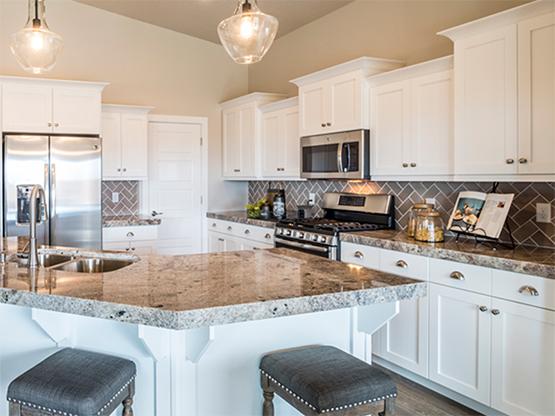Countertop Guide
Countertop Guide
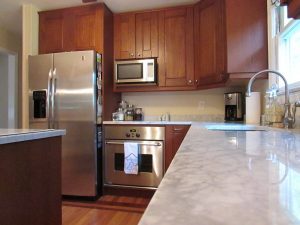
Getting to design your own kitchen can be a very rewarding experience, but the amount of decisions you have to make can be overwhelming. With so many options, it can difficult to know which direction to go. One decision you’ll be facing is what type of counter top material you want. This pros and cons list will help you get acquainted with the most popular options and help you select the ideal material that will compliment your kitchen design. For further questions feel free to contact us here.
Granite
Pros
- Beautiful, naturally-formed design
- Each piece is unique
- Comes in a variety of colors
- Can withstand heat and knives very well
Cons
- Can become easily stained, will require sealing to avoid damage
- Very heavy, must be paired with strong cabinet boxes
Butcher Block
Pros
- Great for country or cottage style kitchens
- Creates a warm and welcoming atmosphere
- Comes in a variety of tones
- Has beautiful natural graining patterns
- Natural wear and tear can add charm and personality but can also be sanded away if desired
Cons
- Can warp because of water damage, will need to be oiled frequently to prevent this
- Can absorb bacteria and will need to be disinfected regularly
Solid Surfacing
Pros
- Great for modern style kitchens
- Very low maintenance, no sealing required
- Damage can be easily sanded away
- Very wide range of color options including vibrant hues not found in nature
Cons
- Artificial man-made look may not appeal to everyone
- Can be just as expensive as granite or other natural materials
Marble
Pros
- Very classy and elegant
- Has a strong defense against heat
Cons
- Has a weak defense against staining, scratching and chipping
- May not be sensible to use throughout whole Kitchen because of price and potential for damage
Quartz Surfacing
Pros
- Simple to maintain
- Great at imitating natural beauty of stone
- Comes in wide variety of color options
- Very durable
Cons
- Can imitate stone, but isn’t quite as good as the real thing
- Can be just as, if not more expensive than stone
Tile
Pros
- Works well in country or old world style kitchens
- Comes in a variety of color options
- Stands up well against staining, heat and knives
- Individual tiles can easily be replaced if chipped
Cons
- Modular aspect makes for an uneven surface that can be difficult for cutting boards or when rolling dough straight onto the counter
- Grout between tiles can attract bacteria or become stained if not sealed
Laminate
Pros
- Getting better and better at mimicking more expensive materials
- Great for designing on a budget
- Easy to clean
- Can be paired with any cabinet base because of its light weight
Cons
- The layers in the material can peel over time
- Susceptible to stains, scratches and burns
- Excessive damage can be difficult to repair
Concrete
Pros
- Works well with industrial chic designs
- Can be tinted to any shade you want and can be inlaid with shells or other interesting materials
- Very durable
- Can withstand heavy use
Cons
- Stains easily so must be sealed frequently
- Can crack if exposed to high levels of heat
- Very heavy and will require strong cabinet base

 Bathtub Focal Point
Bathtub Focal Point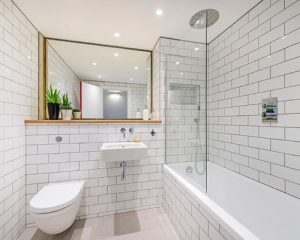 This tile will give a very urban feel and you can choose whatever color of tile you want.
This tile will give a very urban feel and you can choose whatever color of tile you want.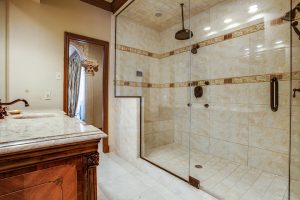 Why? Why not? It is something that is fun. Anything out of the ordinary is something you don’t understand until you actually try it.
Why? Why not? It is something that is fun. Anything out of the ordinary is something you don’t understand until you actually try it.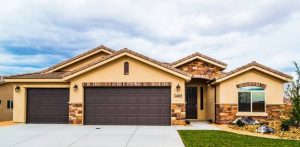 Professionals know what is important because you do not know what is and what is not legal when it comes to building a home. They can let you know what is possible and what is not when it comes to the design.
Professionals know what is important because you do not know what is and what is not legal when it comes to building a home. They can let you know what is possible and what is not when it comes to the design. Start building and make sure you supervise it on occasion to make sure that what is being done is what you had imagined in the beginning. Watching the creation of your house can be a fulfilling experience because it is your own special project.
Start building and make sure you supervise it on occasion to make sure that what is being done is what you had imagined in the beginning. Watching the creation of your house can be a fulfilling experience because it is your own special project. This is all about you and what you want. Don’t start thinking about the costs of materials, the land, or any other tangible thing. Get lost in your own thoughts and the things that you will want in your dream home. ANYTHING GOES! Don’t get bogged down in impossibility, because dreams don’t deal with the impossible.
This is all about you and what you want. Don’t start thinking about the costs of materials, the land, or any other tangible thing. Get lost in your own thoughts and the things that you will want in your dream home. ANYTHING GOES! Don’t get bogged down in impossibility, because dreams don’t deal with the impossible.

 When we say selfie we mean… the house by itself. The brain doesn’t remember things exactly how we first saw them the first time, but photos seem to remind of us of the truth. This will be an integral part of the first phase of home design because it starts to make the dream a reality and will help when part two begins.
When we say selfie we mean… the house by itself. The brain doesn’t remember things exactly how we first saw them the first time, but photos seem to remind of us of the truth. This will be an integral part of the first phase of home design because it starts to make the dream a reality and will help when part two begins.





